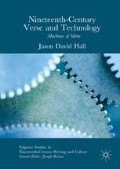Abstract
This chapter examines John Clark’s Eureka Latin Verse Machine, which was much more than a show-place diversion; rather, it was at once the uncanny technological embodiment and a parodic indictment of the Victorian science of prosody and an interactive discursive site where debates about the function of prosody as part of a pedagogical model in the universities and, more specifically, the public schools became immediately visible and accessible to a popular and reform-minded audience. As the Latin hexameters that it was capable of “grinding out” were transcribed, explicated, and judged in the improving pages of popular print media, the Eureka figured briefly as the material signifier of an education reform agenda that was, by and large, hostile to the centrality of prosody in Victorian pedagogy. Exploiting the “mixed” measures of the dactylic hexameter, but reducing their expression to a repeatable pattern, the hexameter machine seemed to some an absurdity: the opposite of the mechanical utility that inspired a contemporary such as Charles Babbage to design a calculating or “thinking” machine. While many saw Clark’s “automaton versifier” as mere curiosity—not unlike the diverting automata of Vaucanson or Kempelen—there was, in the Eureka’s ability to produce a vast number of verses, each one different from the next, an notable intimation of machine intelligence.
Full many a thought, of character sublime,
Conceived in darkness, here shall be unrolled.
The mystery of number and of time.
is here displayed in characters of gold.
Transcribe each line composed by this machine,
Record the fleeting thoughts as they arise;
A line, once lost, may ne’er again be seen,
A thought, once flown, perhaps for ever flies.
—lines inscribed on the Eureka Latin Hexameter Machine (c. 1845)
[T]he works of some poets we could name would sound very well from a machine, if any new Babbage could give a machine voice.
—Tait’s Edinburgh Magazine (1854)
Access this chapter
Tax calculation will be finalised at checkout
Purchases are for personal use only
Author information
Authors and Affiliations
Corresponding author
Rights and permissions
Copyright information
© 2017 The Author(s)
About this chapter
Cite this chapter
Hall, J.D. (2017). Automaton Versifiers. In: Nineteenth-Century Verse and Technology. Palgrave Studies in Nineteenth-Century Writing and Culture. Palgrave Macmillan, Cham. https://doi.org/10.1007/978-3-319-53502-9_4
Download citation
DOI: https://doi.org/10.1007/978-3-319-53502-9_4
Published:
Publisher Name: Palgrave Macmillan, Cham
Print ISBN: 978-3-319-53501-2
Online ISBN: 978-3-319-53502-9
eBook Packages: Literature, Cultural and Media StudiesLiterature, Cultural and Media Studies (R0)

